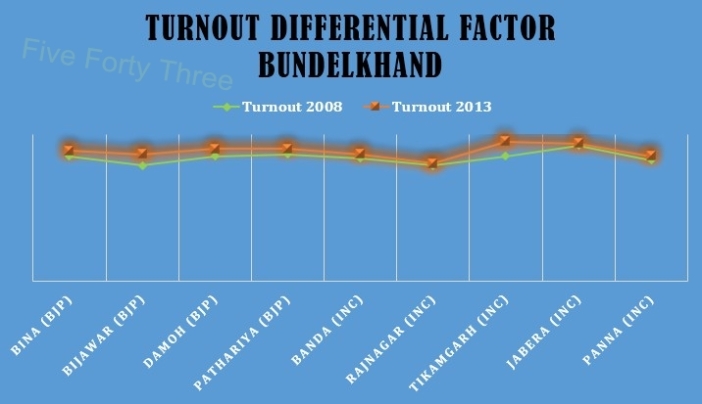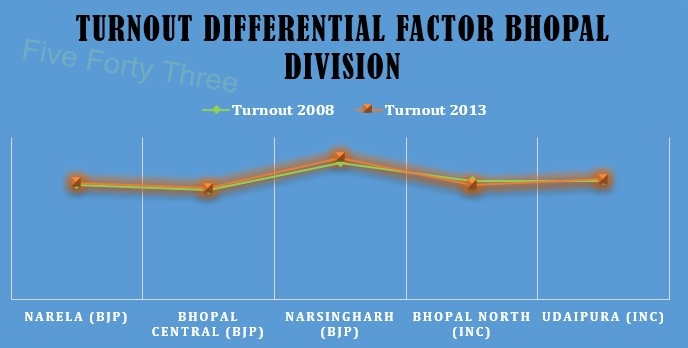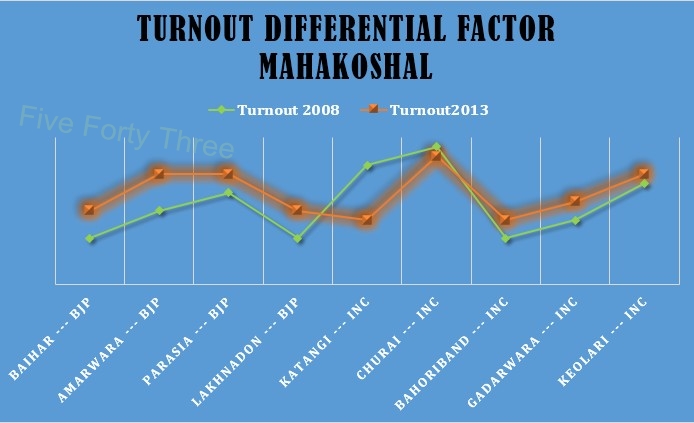Indian elections are a veritable treasure trove for anybody who is interested in collating social-science and mathematical modelling. There are some simple socio-mathematical principles that Indian elections seem to follow. For instance, clear verdict of a single party/alliance majority (especially in assembly elections) is a principle that Indian elections have been following since 2000, which is the exact opposite of the principle of invariably fractured outcomes of the 80s and 90s. Similarly, anti-incumbency was a feature of the elections before 2000, whereas “rewarding governance” is a principle which Indian voters follow in the post 2000 elections (pro-incumbency is a misnomer, for the Indian voter is not a fool to keep on voting without any rewards, therefore we use the term “governance reward”).
One more principle that Indian elections invariably follow is “trend sustenance”; we have seen time and again that any dominant trend in the run-up to an election gets strengthened further towards polling day, eventually producing a clear verdict for the dominant political formation or party. Some recent examples of this principle are Karnataka, Uttar Pradesh, Tamil Nadu and more importantly the 2009 national elections. In all these cases, there was a dominant party in the run up to the election, but a fractured mandate could not be ruled out due to fractured polity of the states involved. Eventually though the verdict was clearly in favor of the dominant political grouping in all these elections.
In the run-up to Madhya Pradesh elections, the dominant trend was that of BJP being ahead, so the basic socio-mathematical principle of Indian election suggests that the ruling party should get rewarded for its governance. Are there any contradictory signals to such a linear graph in the post-poll scenario of Madhya Pradesh? This is a question that confounds election analysts and must be negotiated by staying true to data inputs.
The first usual suspect that is mostly highlighted by the media as per their own whims and fancies is the turnout figure. Especially in these days of high turnouts, many political pundits start unleashing the age-old anti-incumbency horse. Turnout data on its own is not exactly a great indicator to predict Indian elections, but it does give us some clues when used smartly. One of the specific indicators we have created here at 5Forty3 labs is known as “Turnout Differential Factor” which has been adequately back-tested through some of the past election results.
On the whole, the overall turnout in Madhya Pradesh was just about 2 percentage points higher than last time which indicates status-quo at the outset in these days of general higher turnouts. Interestingly, women voter turnout was a good 4 percentage points higher than last time, which probably gives us some inkling of a thumbs-up to the MP government’s welfare schemes. What really matters though is the Turnout Differential Factor of various sub-regions of Madhya Pradesh which we shall analyze now.
Bhopal, Bundelkhand and Gwalior-Chambal zones


 These are the three zones which have stayed true to the pre-poll trends and are showing a status-quo like electoral scenario. As is evident from the charts above, we can easily discern that the battleground seats are behaving similar to our own pre-poll projections. These three zones have a combined total of 85 seats. BJP seems to have an overall upper hand in these three zones and Congress seems to be lagging behind even after the polling. Let us try and correlate this Turnout Differential Data with ground realities;
These are the three zones which have stayed true to the pre-poll trends and are showing a status-quo like electoral scenario. As is evident from the charts above, we can easily discern that the battleground seats are behaving similar to our own pre-poll projections. These three zones have a combined total of 85 seats. BJP seems to have an overall upper hand in these three zones and Congress seems to be lagging behind even after the polling. Let us try and correlate this Turnout Differential Data with ground realities;
- In the Bhopal Division, BJP seems to have maintained its unassailable lead as per all ground reports from that region and the Sangh strategy seems to have worked well at the polling booth level. This division is most likely to produce a status quo result.
- In Gwalior-Chambal zone, the Congress strategy of putting BJP in a spot of bother through an aggressive campaign by “Maharaja” has not succeeded fully and BJP seems to have got its base out to vote. This region should more-or-less maintain status quo and even if BJP loses a couple of seats, it may make that up. In affect a few seats may change hands, but overall results are likely to remain same.
- Uma Bharati has clicked for the BJP as per all reports although there were a lot of suspicions in the run-up to the poll. Bundelkhand should stand with BJP even in this election and Congress has not been very successful in changing its fortunes.
Malwa Region
 As we can see from the above chart of the battleground seats turnouts, although the trend-line has remained unaltered, there are some interesting discrepancies in the Turnout Differential Indicator. What does this mean? There is some micro-anti-incumbency which is showing its impact. Malwa zone also includes the 16 seats of Nimar zone so it makes up a total of 66. BJP had won 40 seats and Congress 25 seats in this zone in 2008, but this time there could be some changes to those numbers. After the polling on Monday, it appears that both the parties are seemingly on a more equal footing in this region. Now let us try and correlate these findings with ground reports;
As we can see from the above chart of the battleground seats turnouts, although the trend-line has remained unaltered, there are some interesting discrepancies in the Turnout Differential Indicator. What does this mean? There is some micro-anti-incumbency which is showing its impact. Malwa zone also includes the 16 seats of Nimar zone so it makes up a total of 66. BJP had won 40 seats and Congress 25 seats in this zone in 2008, but this time there could be some changes to those numbers. After the polling on Monday, it appears that both the parties are seemingly on a more equal footing in this region. Now let us try and correlate these findings with ground reports;
- Polling booth level work of BJP was a bit weak, especially in areas which are considered as its strongholds. This has been a problem for the ruling party in this zone, especially in cities of Malwa; for instance, at many polling booths of Indore it was found that BJP workers were missing during crucial polling hours on Monday (there was even talk of internal sabotage).
- In the lower Malwa tribal districts, Congress seems to have performed better than expected which is quite baffling for many political pundits that we at 5Forty3 talked to.
- In Nimar zone, many reports have come up which are giving Congress a chance to improve its tally – is happening for the first time in almost two decades.
Mahakoshal and Baghelkhand

 These are two very interesting charts that are giving us some wild signals. It was expected that Mahakoshal would be a tight race – in fact, CSDS pre-poll survey had projected that this was the only region where Congress was ahead of BJP – but what has come as a surprise is the behavior of Baghelkhand, which has been a BJP stronghold for a long time now. These two regions have also been clubbed together with Narmada zone and give a combined total of 79 seats. The Turnout Differential Factor of the battleground seats of these 79 constituencies is telling us a story of anti-incumbency, can we correlate these findings with ground reports?
These are two very interesting charts that are giving us some wild signals. It was expected that Mahakoshal would be a tight race – in fact, CSDS pre-poll survey had projected that this was the only region where Congress was ahead of BJP – but what has come as a surprise is the behavior of Baghelkhand, which has been a BJP stronghold for a long time now. These two regions have also been clubbed together with Narmada zone and give a combined total of 79 seats. The Turnout Differential Factor of the battleground seats of these 79 constituencies is telling us a story of anti-incumbency, can we correlate these findings with ground reports?
- Baghelkhand seems to be in a flux of some sorts and there is talk of internal sabotage by BJP workers emanating from this region. Polling booth level workers of BJP in this region seemed to have ditched the party at the last moment on polling day. There were inklings of these in the run-up to the polls when Rajnath Singh rallies had to be cancelled.
- The distressed soya farmers seem to have moved to the Congress and other parties as per reports from this region – the Hoshangabad MP’s shift to BJP seems to have not worked.
- Vaishyas who had stood with the BJP through thick and thin in Baghelkhand seem to have made a shift in this election, although it is not completely clear as yet.
- In Mahakoshal, Congress seems to have an upper hand over BJP owing to local anti-incumbency. Also the crowds that Kamalnath and Jyotiraditya Scindhia managed to gather in their public meetings in this region seem to have been converted into votes.
Note on Internal assessments and Satta Bazaar
Although detailed internal assessments of both the parties are not available, we have information on overall assessments of both the BJP and Congress. BJP is claiming a seat tally of 120 to 135, while Congress claims a tally of 110 to 120. Interestingly, Congress, which had taken a very strong view on the rebels in the state, has now decided not to take any action against the rebels as there are reports that at least 3 of them may emerge victorious and the party may need their support if it falls short of clear majority. State Congress leaders are also in talks with the BSP which is expected to win 6 to 9 seats. BJP on the other hand is confident of a majority on its own. Meanwhile the Satta Bazaar of Indore, which is usually more reliable than that of Mumbai as the local political barometer, indicates 112 to 118 for the ruling BJP and 95 to 100 for the opposition Congress. The odds of a BJP government coming back to power are just 25 Paise for each rupee, whereas the odds for a Congress government coming to power are 3 rupees and 50 paise for every rupee bet. The pertinent point to be noted from all these numbers is the overall perception of a close fight in the state.
Summary
- The most likely scenario, after polling, points to a close race between BJP and Congress, although the ruling party enjoys a definite advantage.
- The possibility of a sweep looks unlikely due to sub-regional discrepancies in voting and whoever wins is likely to win less than 130 seats
- After tabulating the reports from all the regions, BJP seems to be in the band of 112 to 125 seats and Congress seems to be in the 90 to 102 band
[Disclaimer: Five Forty Three doesn’t have access to exit poll data in Madhya Pradesh and the entire analysis of the post-poll scenario is based on ground reports in correlation to turnout data and pre-poll surveys. Such projections carry a higher percentage of error margins of 2% to 5% range]
…Concluded
